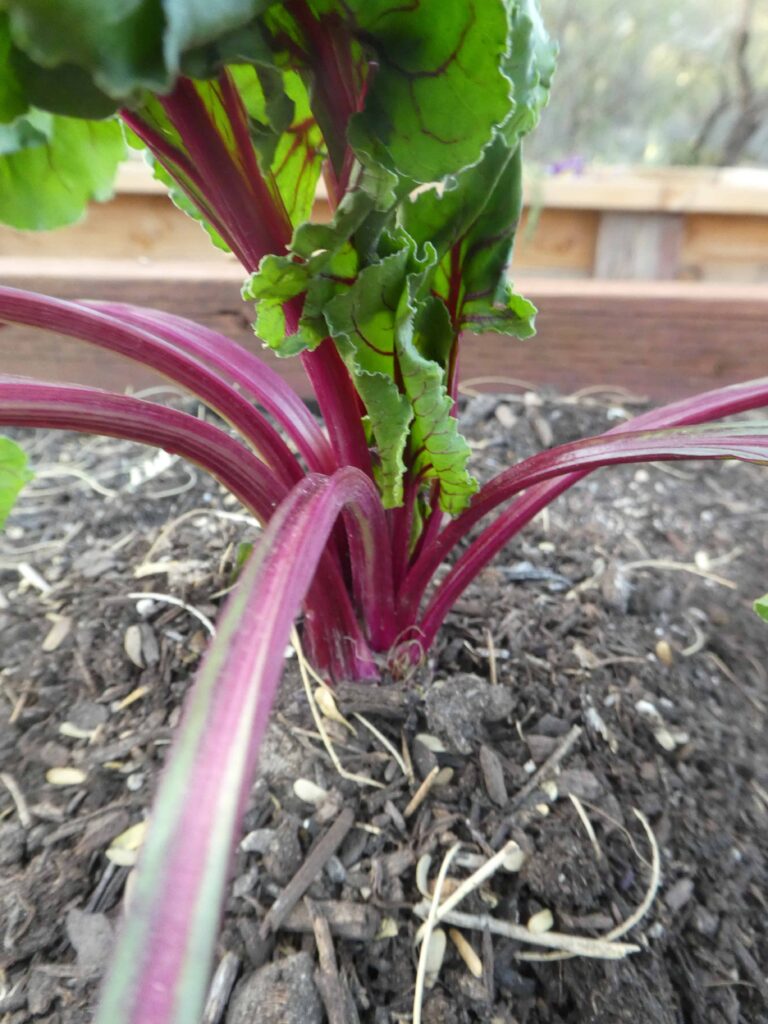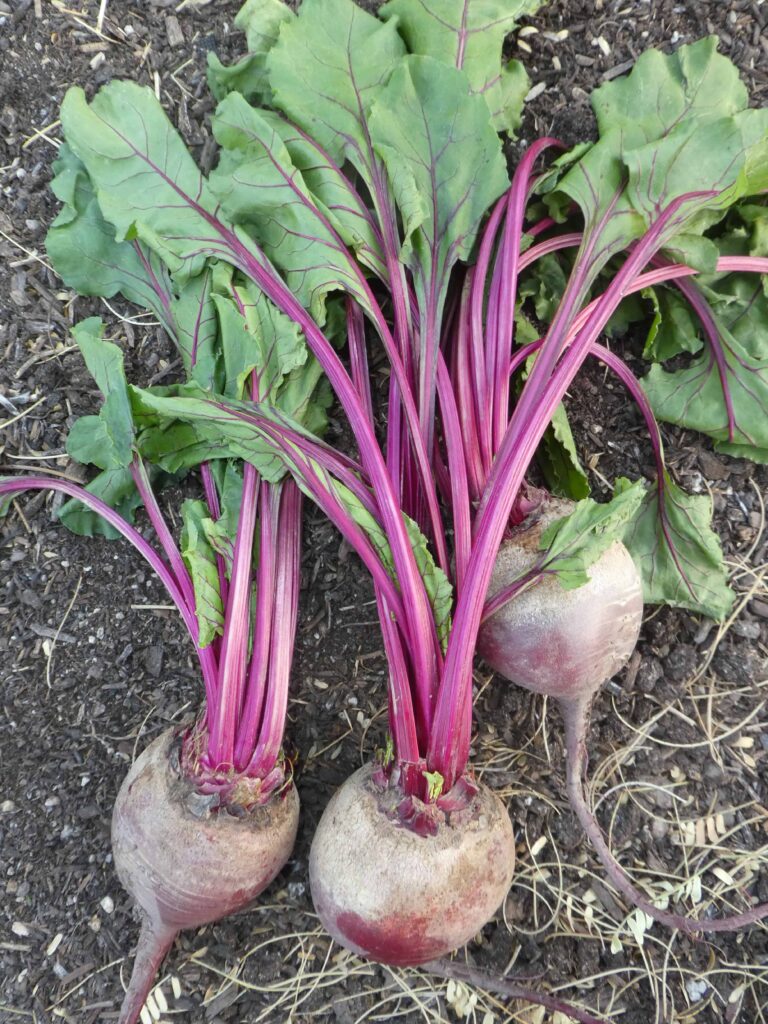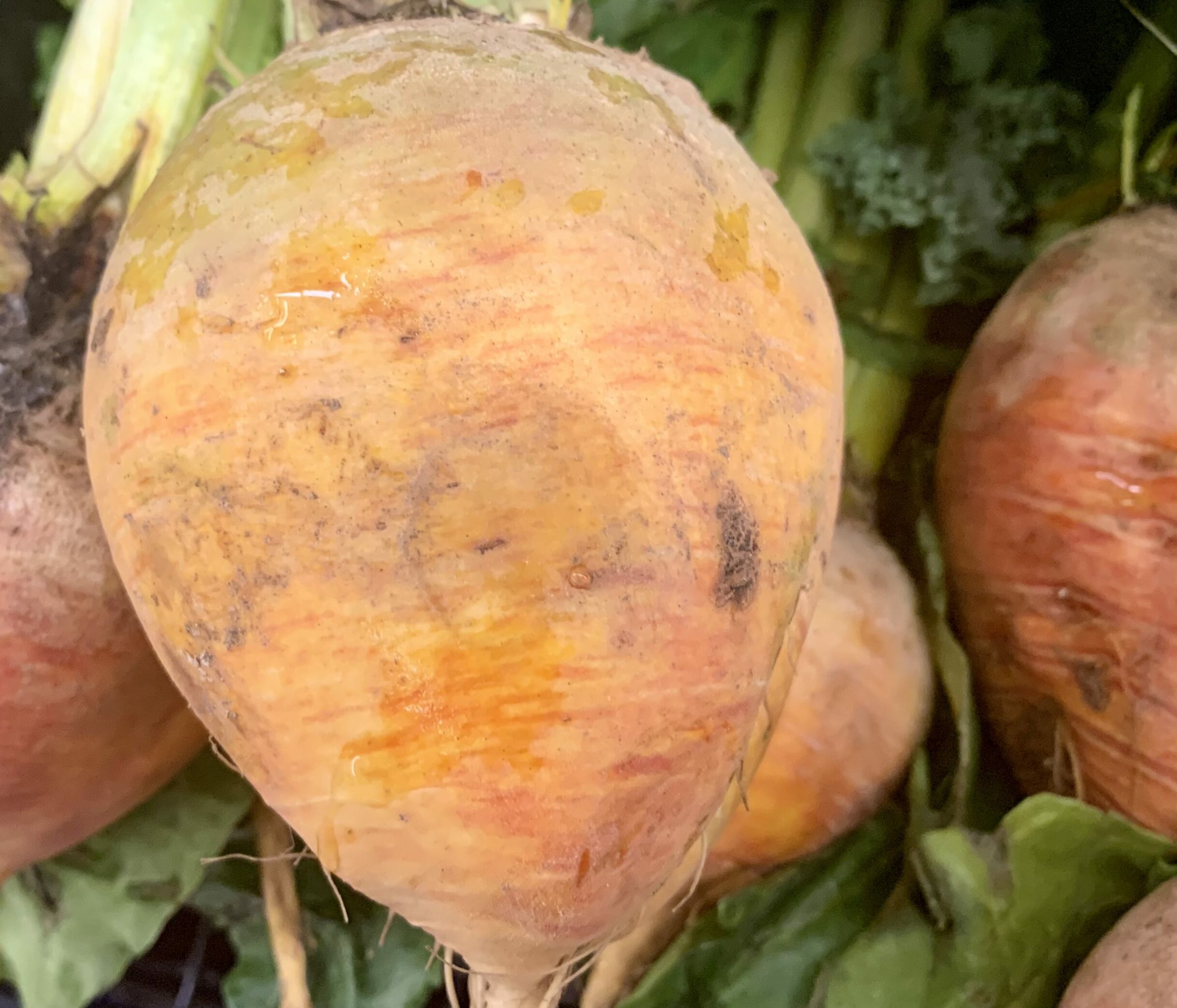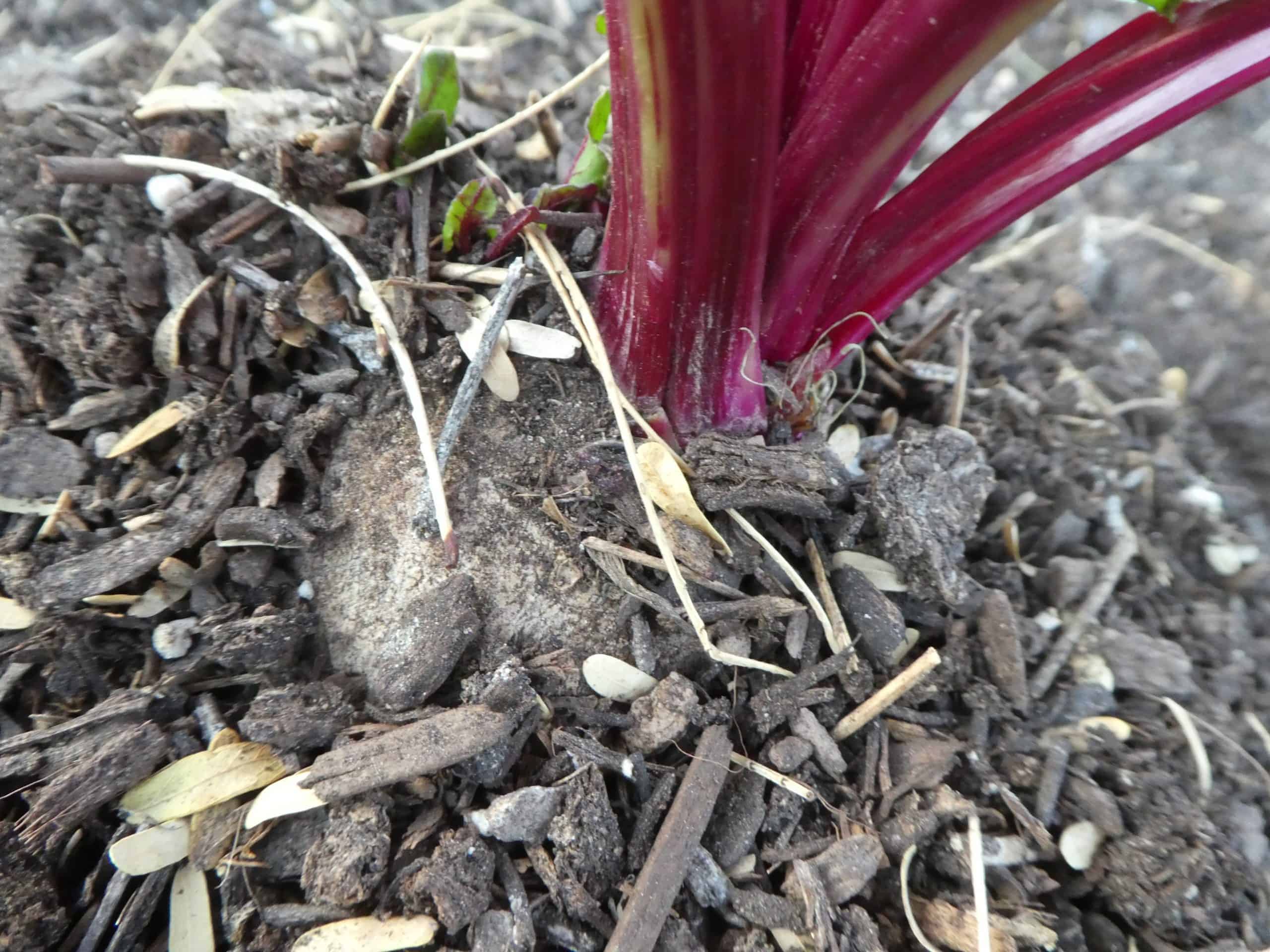Filled with nutrients and a great addition to salads and other dishes, you might be ready to dig into the beets in your garden. However, knowing when to harvest beets is vital to their quality and taste.
Beets grow quickly and will be ready to harvest in less than two months.
In this guide, we’ll help you identify if your homegrown beets are plump and ready for picking. You can eat the beetroot leaves and stems too.
When to Harvest Beets
Keeping track of when you first planted the beets is the most crucial step to ensuring a timely harvest. While it can take 14 – 21 for beet seeds to germinate, beets grow quickly after that.
After 7 – 8 weeks, there’s no right or wrong time to pick a beet as long as you see at least part of the beet growing toward the surface of the soil.
Beetroots tend to push up out of the ground. As they grow, the tops of the roots protrude from the soil. Therefore, you can determine how small or large the beets are using the size of their “shoulders” as a guide.
It’s much the same as if you ever grow carrots. You will see the beet on the surface of the soil. After this time, you can harvest it. It won’t take long to learn how to gauge a beet’s size using this method.
Beet Varieties
When planting beets from seed, pay attention to the type of beet you plant. Like all plants, beets will have different Days to Maturity (DTM). Save the seed packet, or write down the varieties you planted to reference below.
Some faster-growing varieties such as Bull’s Blood and Merlin Hybrid can be mature in less than 50 days. Others, such as Early Wonder and Detroit Supreme, are ready closer to 60 days.
Here are popular beet varieties to grow from fastest-maturing to longest. As you can see, no matter which beets you grow, they will be ready in two months.
- Bull’s Blood: 40 – 52 days (beets best when young)
- Merlin Hybrid: 48 days to maturity
- Avalanche: 50 days
- Chioggia: 54 days
- Early Wonder: 55 – 60 days
- Ruby Queen: 55 days
- Detroit Dark Red: 56 – 59 DTM
- Golden Beet also called Golden Detroit Beet: 58 days
- Detroit Supreme: 60 – 65 days
- Cylindra: 60 days
Harvesting Small or Large Beets
You can harvest beets when they are smaller, as soon as you see them emerging. Some gardeners pick them early because smaller beetroots have a more robust flavor.
Some beets are sweeter than others which can an earthy flavor.
Others prefer to wait to pick them after 2 months when the beets are larger. Depending on the types of beets you grow, you can leave some in the ground for up to 4 months (12 weeks).
As the beets stay in the ground longer, they will continue to mature and grow larger.
The larger beetroots become, there is a greater chance for them to become woody and tough. If you have several beet plants growing, it’s best to cultivate them at different times to see what size you prefer.
Some beet varieties are meant to be picked smaller than others.

Beet Size
You can harvest baby beets when they are at least one inch in diameter. Otherwise, they can grow to be 2 – 3″ for mature beets.
Depending on the variety you plant, beets will grow to be different sizes:
- Early Wonder: 3 – 4 inches in diameter
- Chioggia: 2 inches in diameter
- Bull’s Blood: 2 – 3 inches in diameter
- Detroit Supreme: 2 inches in diameter
- Cylindra: Grows like a cylinder, more like a carrot; 6 – 9 inches long; as they grow, they can fill out like a potato
Harvesting Beet Greens
While it’s important to know when to harvest beets, remember the greens as well. The beetroot isn’t the only part of the plant that people consider before choosing a time to harvest.
If you’re planning on eating the green tops from the beets, timing matters too. You can cook them as you would spinach or eat them raw in salads. The tops, including the leaves and stems, are edible.
If you’d like a milder leaf flavor, aim to gather the beets around the 45-day mark. In that case, you can even cook the root and top in the same pot.
Can You Pick Beet Greens Before the Root?
You can pick beet greens before the root. Beet leaves will be milder when they are younger. Aim to harvest the leaves when they are 6 inches in length, especially if you will eat them raw. This is when they have 3 – 4 weeks of growth.
Pick the outer leaves, not the inside and center leaves. Carefully snip one or two of the largest, outer leaves from each plant so that the beets will continue growing.
Picking Beet Greens and Beetroots at the Same Time
You can also harvest the entire beet plant at once. If you won’t be eating the beet greens, try to compost them or give to your chickens or someone who has chickens. But try cooking or sautéing them, especially if they are large leaves, over 6 inches. They will have a stronger, bitter flavor the longer they grow.
Depending on the variety you plant, the green leaves and red stalks and stems grow to varying heights. If you harvest the beet the same time you harvest the greens, the greens will grow large.
- Green Top Bunching: 15 inch tops
- Chioggia: 8 – 10 inches
- Early Wonder: 18 inches; these are extra tall greens
- Detroit Supreme: 8 – 12 inches
Larger beetroots, which also correspond with a darker green color, have tops with a stronger flavor.

Harvesting Beets
You can do a spring planting and continue to plant throughout the summer if temperatures are mild (not consistently above 75 degrees F). Also consider a fall planting.
As an example, in growing zone 5, you can start beet seeds outdoors mid-May to mid-June. Beetroots will be ready to harvest in July or August.
If you did a fall planting in August to mid-September, beets will be ready late September through early November.
How to Pick Beets
Harvesting beets can take some muscle, so you can make it easier on yourself by thoroughly watering the beets you want to pick one or two days in advance. Then, take hold of the stems at their base and pull until they release from the ground.
Alternatively, you can dig a group of beets out with a shovel, but this increases the chance of damaging other beets around it. Since many people prefer to pull up small batches of beets at a time, the first method is most common.
Storing Beets
The good news is that if you pick beets on time, they store well for up to a couple of weeks in the refrigerator. Store the greens in plastic bags in the crisper drawer. They will last a week.
Of course, you can also pickle, can, or freeze beets so that you can enjoy your large harvest year-round.
Keep the beet greens in the refrigerator crisper and wash them when you are ready to use them.

How Long Does It Take Beets to Grow?
Beets are a fast-growing root vegetable, reaching maturity within two months. Since they grow best in cooler weather, you can plant them in both spring and fall.
In fact, if you live in a place with mild winters, you can even squeeze in a third planting season.
Waiting Too Long To Harvest
It’s equally important to know when to harvest beets as it is how to tell if you waited too long to pick them. You may have planted them and forgotten about them or perhaps you were on vacation when they reached maturity.
Depending on your climate, overripe beets become soft and wilted. They may have visible signs of rot or have an unpleasant smell. If they received too much water or if the soil didn’t drain well, they can rot.
They can also become too tough to eat. They won’t be sweet or flavorful. In these instances, toss them in the compost pile or discard them.
Beet Growth Cycle
Once you plant beet seeds in loose, nutrient-rich soil, you can expect to see the first germination within ten days. The next stage is leaf development. During this period, you’ll see leaves unfold in two pairs at a time.
Beets then enter the rosette growth stage when they grow and begin covering large parts of the ground.
At the end of this stage, which is about 1.5 months into the beet growth cycle, you can start harvesting small beets and young leafy tops.
Once the beet plant leaves expand, the inflorescence emergence stage starts, which is when the main stem elongates, and other stems grow from the sides.
The flowering, fruit, and ripening stages follow, which are all excellent times to harvest beets.
Reasons for Slow Growth in Beets
Of course you are ready to enjoy your beet harvest! But sometimes they take longer to grow.
One of the biggest reasons that beets grow slowly is because they are planted too close together. It’s essential to plant your beets in rows 12 inches apart and create three inches of space between the seedlings.
(You can plant Cylindra beets closer together because they grow lengthwise more-so than widthwise.)
Doing so offers the roots plenty of room to grow large bulbs, and it also ensures enough sunlight reaches the leaves.
Another reason your beets might be growing too slow is that the soil has too much nitrogen and not enough phosphorus to balance it out. In that case, you’ll most likely notice that your beets have beautiful, lush tops but little signs of the beetroot poking up above the soil.
To increase the phosphate concentration of your soil, you can use a fertilizer with phosphorus. Alternatively, pour some bone meal around the soil and watch just how quickly your beets grow.
If you’ve tried these suggestions but are still struggling with slow-growing beets, it could be because your soil is too acidic.
Beets grow best in soil with a pH rating of 5.6 or higher. If you test your soil and it’s too acidic, try mixing the soil with lime. It’s also vital that you plant your beets in sandy, airy soil so that the roots can more easily grow.
If temperatures are consistently hot, it will also interfere with growth and harvest times. They are cool season crops. You’ll need to harvest them before temperatures heat up.
Are Your Beets Ready for Harvesting?
What’s great about knowing when to harvest beets is if you don’t remember when you planted them, you can use the shoulder method to harvest a few. If you are happy with their sizes, you can pick the rest. If you prefer them to grow larger, you can wait another week or two.
Now that you know when to harvest beets, head out to your garden and check if your beets are ready for picking. You can even try planting a new batch every couple of weeks in the early spring and fall so that you can enjoy fresh beets at the size of your liking for a longer period.
Knowing how and when to harvest beets will make growing them worthwhile. You’ll pick and enjoy them when they are ripe and flavorful.
Winter Vegetables List to Plant for Year-Round Growing

